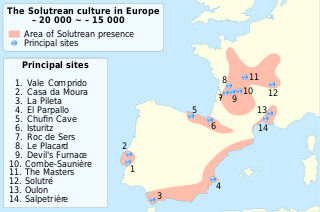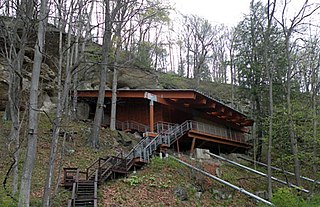
The Solutrean industry is a relatively advanced flint tool-making style of the Upper Paleolithic of the Final Gravettian, from around 22,000 to 17,000 BP. Solutrean sites have been found in modern-day France, Spain and Portugal.

Clovis points are the characteristically fluted projectile points associated with the New World Clovis culture, a prehistoric Paleo-American culture. They are present in dense concentrations across much of North America and they are largely restricted to the north of South America. There are slight differences in points found in the Eastern United States bringing them to sometimes be called "Clovis-like". Clovis points date to the Early Paleoindian period, with all known points dating from roughly 13,400–12,700 years ago. As an example, Clovis remains at the Murry Springs Site date to around 12,900 calendar years ago. Clovis fluted points are named after the city of Clovis, New Mexico, where examples were first found in 1929 by Ridgely Whiteman.

The Clovis culture is an archaeological culture from the Paleoindian period of North America, spanning around 13,050 to 12,750 years Before Present. Found in localities across the continent, the type locality is Blackwater Draw locality No. 1 near Clovis, New Mexico, where stone tools were found in association with the remains of Columbian mammoths in 1929. The most distinctive part of the Clovis culture toolkit are Clovis points, these fluted lanceolate points are typically large in size, the largest exceeding 10 centimetres (3.9 in) in length. Other stone tools used by Clovis culture include knives, scrapers and bifacial tools, with bone tools including beveled rods and shaft wrenches, with possible ivory points also being identified. The Clovis culture is suggested to have also heavily utilized hide, wood and natural fibres, though no direct evidence of this has been preserved. A distinctive feature of the Clovis culture is the deposition of "caches", which are sets of artifacts that were deliberately deposited with the expectation of being later retrieved. Over 20 Clovis caches have been identified.

Monte Verde is a Paleolithic archaeological site in the Llanquihue Province in southern Chile, located near Puerto Montt, Los Lagos Region. It contains two separate layers, the younger Monte Verde II, dating to 14,500 cal BP, and an older, much more controversial layer suggested to date to 18,500 cal BP. The Monte Verde II site has been considered key evidence showing that the human settlement of the Americas pre-dates the Clovis culture by roughly 1,000 years. This contradicts the previously accepted "Clovis first" model which holds that settlement of the Americas began after 13,500 cal BP. The Monte Verde findings were initially dismissed by most of the scientific community, but the evidence then became more accepted in archaeological circles.
Topper is an archaeological site located along the Savannah River in Allendale County, South Carolina, United States. It is noted as a location of artifacts which some archaeologists believe to indicate human habitation of the New World earlier than the Clovis culture. The latter were previously believed to be the first people in North America.

The Folsom tradition is a Paleo-Indian archaeological culture that occupied much of central North America from c. 10800 BCE to c. 10200 BCE. The term was first used in 1927 by Jesse Dade Figgins, director of the Denver Museum of Nature and Science. The discovery by archaeologists of projectile points in association with the bones of extinct Bison antiquus, especially at the Folsom site near Folsom, New Mexico, established much greater antiquity for human residence in the Americas than the previous scholarly opinion that humans in the Americas dated back only 3,000 years. The findings at the Folsom site have been called the "discovery that changed American archaeology."
Robson Bonnichsen was an anthropologist who undertook pioneering research in First American studies, popularized the field and founded the Center for the Study of Early Man at the University of Maine (Orono) in 1981. Dr. Bonnichsen, an associate professor of Anthropology and Quaternary studies, created the Center and served as its first director. The establishment of the Center was made possible through a generous donation by the Bingham Trust. In 1990, the name of the Center was changed to the Center for the Study of the First Americans. In 1991, Dr. Bonnichsen moved the Center from Maine to Oregon State University in Corvallis. The Center relocated to its current home at Texas A&M University in the summer of 2002 to be in a more active academic setting with new education, research, and outreach opportunities. Dr. Bonnichsen served as the Center Director until his death in December 2004. Dr. Bonnichsen and his colleagues believed that humans colonized North America long before 11,000 years ago, when people of the Clovis culture left their signature artifacts in North America.
Buhla is the name for a skeleton of a prehistoric (Paleo-Indian) woman found in a quarry near Buhl, Idaho, United States, in January 1989. The skeleton's age has been estimated by radiocarbon dating at 10,675 ± 95 BP, which confirms this as one of the oldest sets of human remains found in the Americas. The discovery was made by a quarry worker when he noticed what was found to be a thigh bone in the screen of a rock crusher. The nearly complete skeleton was subsequently unearthed nearby.

The Meadowcroft Rockshelter is an archaeological site which is located near Avella in Jefferson Township, Pennsylvania. The site is a rock shelter in a bluff overlooking Cross Creek, and contains evidence that the area may have been continually inhabited for more than 19,000 years. If accurately dated, it would be one of the earliest known sites with evidence of a human presence and continuous human occupation in the New World.
Cactus Hill is an archaeological site in southeastern Virginia, United States, located on sand dunes above the Nottoway River about 45 miles south of Richmond. The site receives its name from the prickly pear cacti that can be found growing abundantly on-site in the sandy soil. Cactus Hill may be one of the oldest archaeological sites in the Americas. If proven to have been inhabited 16,000 to 20,000 years ago, it would provide supporting evidence for pre-Clovis occupation of the Americas. The site has yielded multiple levels of prehistoric inhabitance with two discrete levels of early Paleo-Indian activity.

The Solutrean hypothesis on the peopling of the Americas claims that the earliest human migration to the Americas took place from Europe, with Solutreans traveling along pack ice in the Atlantic Ocean. This hypothesis contrasts with the mainstream academic narrative that the Americas were first populated by people crossing the Bering Strait to Alaska by foot on what was land during the Last Glacial Period or by following the Pacific coastline from Asia to America by boat.

The Paisley Caves or the Paisley Five Mile Point Caves complex is a system of eight caves in an arid, desolate region of south-central Oregon, United States north of the present-day city of Paisley, Oregon. The caves are located in the Summer Lake basin at 4,520 feet (1,380 m) elevation and face west, carved into a ridge of Miocene and Pliocene era basalts mixed with soft volcanic tuffs and breccias by Pleistocene-era waves from Summer Lake. One of the caves may contain archaeological evidence of the oldest definitively-dated human presence in North America. The site was first studied by Luther Cressman in the 1930s.
Bluefish Caves is an archaeological site in Yukon, Canada, located 54 km (34 mi) southwest of the Vuntut Gwichin community of Old Crow. It has been controversially suggested that human occupation radiocarbon dates to 24,000 years Before Present (BP) based on radiocarbon dating of animal remains, but these dates are contested due to the uncertain stratigraphic context of the archaeological remains relative to the dated animal remains. There are three small caves in the area.
Juliet Morrow is an American archaeologist and a professor of Anthropology at Arkansas State University in Jonesboro, Arkansas.
Pendejo Cave is a geological feature and archaeological site located in southern New Mexico about 20 miles east of Orogrande. Archaeologist Richard S. MacNeish claimed that human occupation of the cave pre-dates by tens of thousands of years the Clovis Culture, traditionally believed to be one of the oldest if not the oldest culture in the Americas.

The Riverside Site, also known as 20-ME-1, is an archaeological site located near the Riverside Cemetery in Menominee, Michigan. It was listed on the National Register of Historic Places in 1978.
Haplogroup Q-Z780 is a subclade of the Y-DNA Haplogroup Q-L54. Q-Z780 is defined by the presence of the Z780 Single Nucleotide Polymorphism (SNP).
Anzick-1 is a Paleo-Indian male infant whose remains were found in south central Montana, United States, in 1968, and date to 13,000–12,850 years BP. The child was found with more than 115 tools made of stone and antlers and dusted with red ocher, suggesting an honorary burial. Anzick-1 is the only human who has been discovered from the Clovis Complex, and is the first ancient Native American genome to be fully sequenced.

The peopling of the Americas began when Paleolithic hunter-gatherers (Paleo-Indians) entered North America from the North Asian Mammoth steppe via the Beringia land bridge, which had formed between northeastern Siberia and western Alaska due to the lowering of sea level during the Last Glacial Maximum. These populations expanded south of the Laurentide Ice Sheet and spread rapidly southward, occupying both North and South America, by 12,000 to 14,000 years ago. The earliest populations in the Americas, before roughly 10,000 years ago, are known as Paleo-Indians. Indigenous peoples of the Americas have been linked to Siberian populations by linguistic factors, the distribution of blood types, and in genetic composition as reflected by molecular data, such as DNA.
The theory known as "Clovis First" was the predominant hypothesis among archaeologists in the second half of the 20th century to explain the peopling of the Americas. According to Clovis First, the people associated with the Clovis culture were the first inhabitants of the Americas. This hypothesis came to be challenged by ongoing studies that suggest pre-Clovis human occupation of the Americas. In 2011, following the excavation of an occupation site at Buttermilk Creek, Texas, a group of scientists identified the existence "of an occupation older than Clovis." At the site in Buttermilk, archaeologists discovered evidence of hunter-gatherer group living and the making of projectile spear points, blades, choppers, and other stone tools. The tools found were made from a local chert and could be dated back to as early as 15,000 years ago.













